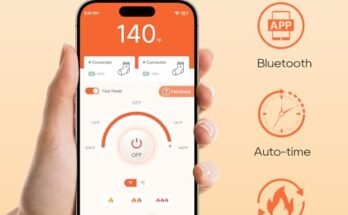People with type 2 diabetes can safely undergo lymphatic drainage with proper medical guidance. This therapy may help reduce fluid retention and swelling.
Lymphatic drainage is a gentle massage technique designed to stimulate the flow of lymph fluid around the body, which can offer numerous health benefits, including improved circulation and detoxification. For those managing type 2 diabetes, it’s essential to monitor blood sugar levels and stay in close communication with healthcare providers when considering treatments like lymphatic drainage.
This therapy can be an excellent complement to a comprehensive diabetes management plan, as long as it is tailored to individual health needs and performed by a professional. Engaging in lymphatic drainage may lead to better blood glucose control and a healthier lymphatic system overall, contributing positively to the management of type 2 diabetes.
:max_bytes(150000):strip_icc()/carly-before-after-square-9e3e8d96bf2d46ba9c039e9802c8ed16-d3ba9506adb54a68acb4d1f718e6d54a.jpg)
Credit: www.byrdie.com
The Intersection Of Type 2 Diabetes And Lymphatic Drainage
Discover the link between Type 2 Diabetes and Lymphatic Drainage. People living with diabetes must manage various health aspects. Lymphatic drainage might be a new term for many, but it’s critical to understand this process. Especially, when it relates to chronic conditions like Type 2 Diabetes.
Understanding Type 2 Diabetes
Type 2 Diabetes affects how your body processes blood sugar. With this condition, your body either resists insulin or doesn’t produce enough. This leads to high blood sugar levels. It’s important to manage these levels to avoid health issues. Complications can impact heart, kidneys, and even your blood vessels.
- High blood sugar levels can cause damage
- Insulin resistance is a key factor
- Heart, kidney, and vessel health are at risk
Basics Of Lymphatic Drainage
Lymphatic drainage is a gentle massage technique. It’s designed to help the flow of lymph fluids in your body. These fluids carry waste products away from tissues and back toward the heart. Proper lymphatic function is essential for a healthy immune system.
| Benefits | Process |
|---|---|
| Improves fluid flow | Gentle massaging |
| Removes waste products | Enhances immune response |
| Supports overall health | Done by professionals |
Can people with Type 2 Diabetes undergo lymphatic drainage? Yes, with careful consideration. It’s vital to consult professionals before starting. They will guide you based on your health status. The procedure can complement diabetes management and improve well-being if done correctly.
- Consultation is key
- Professionals can provide tailored guidance
- Procedure can aid diabetes management

Credit: www.everydayhealth.com
Potential Benefits Of Lymphatic Drainage For Diabetics
For those managing type 2 diabetes, lymphatic drainage might be a beacon of relief. This therapy focuses on stimulating the flow of lymph, a fluid involved in removing waste and toxins from the body’s tissue. The benefits could be immense for diabetics, impacting overall health and wellness.
Enhanced Circulation
Lymphatic drainage can enhance blood flow. This can be crucial for diabetics, as better circulation aids in delivering much-needed nutrients and oxygen to cells.
The slow movement involved in the technique promotes capillary formation and can reduce risks associated with poor circulation.
Reduced Swelling And Inflammation
Chronic inflammation hinders insulin function. Lymphatic drainage may alleviate this concern. Through gentle massage, this therapy can help reduce tissue swelling, which is common in diabetics.
- Lowers uncomfortable puffiness
- Boosts tissue health
- Enhances immune response
Risks And Considerations For Diabetics
Living with Type 2 diabetes requires careful attention to health, especially when considering treatments like lymphatic drainage. Whilst it can offer benefits, it’s vital to discuss potential risks and considerations with a healthcare provider. Here’s what to keep in mind:
Monitoring Blood Sugar Levels
For individuals with diabetes, keeping blood sugar levels stable is essential. Lymphatic drainage could affect these levels. Thus, close monitoring during and after treatment is crucial. Diabetics should remember:
- Check blood glucose before and after sessions to detect any unexpected changes.
- Keep a glucose monitoring device handy during treatments.
- Adjust diabetes medications as advised by healthcare professionals if there are significant fluctuations.
Awareness Of Infection Risks
With Type 2 diabetes, the risk of infection is higher. The skin is a barrier against infection, and any therapy applied to the skin needs extra precaution. Here are key points for diabetics:
- Choose a certified lymphatic drainage therapist to minimize the risk of infection.
- Inspect the skin for cuts or sores before treatment, as bacteria can enter through these openings.
- Report any unusual signs like redness, swelling, or warmth to a healthcare provider promptly.
By considering the unique needs of their condition, those with Type 2 diabetes can approach lymphatic drainage with the right knowledge. Comfort and safety should always be the priority.
Best Practices For Lymphatic Drainage In Diabetic Care
For individuals managing Type 2 diabetes, incorporating lymphatic drainage may offer health benefits. This therapy aids in detoxifying the body, improving circulation, and reducing swelling. But, it is essential to understand the best practices to ensure safety and effectiveness.
Professional Consultation Is Key
Before beginning any new treatment, speaking with a healthcare provider is vital. They understand the complexities of diabetes and how it affects the lymphatic system. A professional will assess your conditions and tailor a lymphatic drainage strategy to suit your needs. Never start treatment without medical advice.
Frequency And Duration Of Treatments
When incorporating lymphatic drainage into diabetic care, the frequency and duration of sessions will vary. Your healthcare provider will guide you. They might recommend shorter, more frequent sessions to monitor how your body responds. It’s crucial to track blood sugar levels closely before and after treatments to ensure stability.
- Always monitor blood sugar before and after treatment.
- Follow the schedule prescribed by your healthcare professional.
- Stay hydrated to help the lymphatic system flush out toxins.
Personal Experiences And Case Studies
Exploring real-world experiences provides insight into lymphatic drainage for type 2 diabetes. Case studies highlight its impact on health and wellness.
Success Stories Of Lymphatic Drainage
Many individuals with type 2 diabetes report positive results from lymphatic drainage therapy.
- Improved blood sugar control – Patients note better glucose levels.
- Reduced swelling – Reports show decreased limb swelling.
- Enhanced circulation – Some observe better blood flow.
For instance, John, a 58-year-old with type 2 diabetes, experienced less foot swelling. He found that his insulin reception improved after regular sessions. Mary, 47, felt increased energy and saw her sugar readings stabilize. These accounts suggest that lymphatic drainage could benefit type 2 diabetes management.
| Name | Age | Improvement |
|---|---|---|
| John | 58 | Foot swelling and insulin reception |
| Mary | 47 | Energy and sugar level stability |
When Lymphatic Drainage May Not Help
In some cases, lymphatic drainage might not provide the desired effects for diabetes-related conditions.
- Persistent edema due to venous insufficiency may not improve.
- Advanced neuropathy could interfere with treatment benefits.
- Heart or kidney issues may complicate lymphatic therapy.
Linda’s story sheds light on such scenarios. Despite therapy, her lower leg edema remained unchanged. Her doctors revealed underlying venous issues that needed medical attention. This emphasizes the importance of medical guidance when considering lymphatic drainage. Each case is unique, and while it may help many, it isn’t a universal solution.
Integrating Lymphatic Drainage Into A Diabetes Management Plan
Those with type 2 diabetes often seek ways to improve their well-being. Lymphatic drainage emerges as a potential complementary therapy. This gentle massage encourages the natural drainage of the lymph. It can help manage diabetes-related swelling.
Collaborative Healthcare Approach
Teaming up with healthcare providers is vital for those with diabetes who consider lymphatic drainage. This therapy should mesh with the existing diabetes management plan. A healthcare team can monitor progress.
- Consulting a doctor is the first step to ensure lymphatic drainage suits the individual’s health condition.
- Working closely with a certified lymphatic therapist ensures the procedure is safe and effective.
- Regular monitoring of blood sugar levels helps track any changes that occur with the introduction of lymphatic drainage.
Lifestyle Adjustments For Optimal Results
Lifestyle changes can maximize the benefits of lymphatic drainage. Combining this therapy with healthy habits can lead to better results.
| Change | Benefit |
|---|---|
| Regular Exercise | Boosts lymph flow, reduces blood sugar |
| Hydration | Supports lymph fluid movement |
| Low-Salt Diet | Limits fluid retention, aids in managing diabetes |
Including physical activity in daily routines can help. Staying hydrated is also essential for proper lymph flow. Keeping salt intake low prevents unnecessary fluid retention. These daily habits can support lymphatic drainage therapy.
:max_bytes(150000):strip_icc()/GettyImages-1357320952-2e3559dea93846838330e1b548d5f196.jpg)
Credit: www.health.com
Frequently Asked Questions On Can People With Type 2 Diabetes Do Lymphatic Drainage
Does Lymphatic System Affect Diabetes?
The lymphatic system can influence blood sugar levels and insulin resistance, potentially impacting diabetes management and progression.
What Is The Lifespan Of A Person With Type 2 Diabetes?
The lifespan of a person with type 2 diabetes can vary. Proper management of the condition often leads to a normal or near-normal life expectancy. Uncontrolled diabetes may result in complications, potentially reducing lifespan.
What Are The Contraindications For Massage For Type 2 Diabetes?
Contraindications for massage in type 2 diabetes include poor blood circulation, neuropathy, and if skin ulcers or infections are present. Patients should consult healthcare providers before receiving massages.
Does Sugar Affect Lymphatic System?
Excessive sugar intake can lead to inflammation, potentially impairing the lymphatic system’s function. This can disrupt the system’s role in immune response and fluid balance.
Conclusion
Managing type 2 diabetes requires careful consideration of health practices. Lymphatic drainage is one such practice that, under professional guidance, may be beneficial. Consult with a healthcare expert to address individual health needs. Embrace each step toward well-being, and remember, your journey’s success is unique to you.



